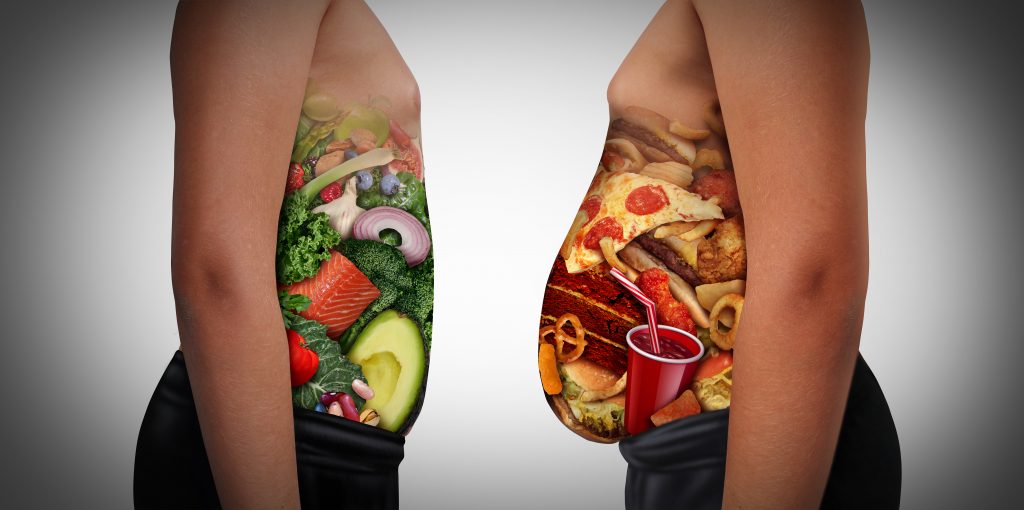We all associate smoking weed with that gnawing hunger that feels like starvation, and the term ‘munchies’ is well known for its association with sweet, salty, and fatty foods. So why are stoners generally skinny? It’s an age-old question that is starting to have some answers through recent research. In fact, one of the interesting components of smoking cannabis, might be in keeping the endocannabinoid system in check, as an over-active cannabinoid system, is often associated with obesity.
If the endocannabinoid system is related to obesity, then cannabis could play a big role in dealing with it, particularly with compound THCV. THCV is one of many cannabis cannabinoids to make it to store shelves, along with the likes of delta-8 THC, HHC, and THC-O-A. If you’re concerned about your weight this holiday season, think about giving THCV a shot, you never know, could make a difference. We’ve got tons of deals for the holidays, so go ahead and start your shopping today, (or finish it if you didn’t wait til the last minute)! Make sure to subscribe to The THC Weekly Newsletter for deals on legal cannabis products, as well as all the latest news and industry stories. Also save big on Delta 8, Delta 9 THC, Delta-10 THC, THCO, THCV, THCP & HHC products by checking out our “Best-of” lists!
First off, what’s obesity?
To simply say that ‘obese’ means ‘fat’ is a bit of an understatement. We all know the term ‘fat’ to be wide-ranging of course. We use it for anything from a little extra gut flab to a person twice the size they technically (and healthily) should be. But ‘obese’ is actually way more specific. Whereas simply being overweight means having a BMI over 25%, ‘obese’ specifically relates to a BMI of over 30%. The two terms, ‘overweight’, and ‘obese’ also come with the connotation of not just excess fat, but enough to present a health risk.
If you’re wondering what ‘BMI’ means, this stands for ‘body mass index’, and is a measure of a person’s weight in kilograms, divided by height in meters squared. Therefore, its written as mg/kg, so a BMI of 25 looks like this: 25kg/m2. While there is no ‘right’ BMI, since we all vary in our builds, particularly in bone density, it suffices to say that a standard or average adult BMI is between 18.5-24.9. Being above or below does not have to indicate a weight issue, but it does make it more likely.
It suffices to say that this is a growing problem (no pun intended). While some like to point at more sedentary lifestyles as the culprit, the much more concerning factor is the food we eat, and the increasingly lower quality of it, which has allowed for this ballooning out. That developing countries have this same issue (when they used to be the skinnier countries, and without intervention, places without a lot of processed foods) says a lot of awful things about what rich agricultural companies push on those who can’t afford to say no. But that’s an article for a different time, probably for a different publication.
How big is the obesity problem?
When it comes to America – the home of obesity, the statistics can get quite staggering. According to the CDC, in 2017-2018, a staggering 42.4% of the population weighed in as obese. That means that nearly an entire half of the population was not only overweight, but qualifying as obese. When measuring the increase, the rate shot up 30.5% between the years of 1999-2018. In the same time period, severe obesity (BMI greater than 40) went up from 4.7% to 9.2%.
On a larger scale (no pun intended again), the WHO’s global burden of disease statistics state that in 2017, over four million people died worldwide due to being overweight or obese. The rates have been growing quite quickly, with an increase of 4% to 18% in children alone (ages 5-19) between the years of 1975-2016. Funny thing is, it’s usually stated that the majority of obese children are from developing countries due to poor nutrition issues, with those areas seeing a 30% bigger increase in such cases. Yet the US, one of the richest countries, still remains #1.

In terms of the problems caused by obesity, the list is endless. Being overweight, especially to intense degrees, will have a negative impact on nearly every body function. Just think how much harder your heart has to work if it has to pump blood for a body double the size it’s supposed to be. And then consider diabetes, and how many Type II cases are out there as a result of bodies being too big to produce enough insulin to account for the amount of sugar being ingested.
Diabetes in and of itself has become an insanely big health issue, effecting 422 million in 2014, up from 108 million in 1980, according to WHO. Globally the number increased threefold since 1975. Premature death rates have increased by 5% between the years of 2000-2016 because of diabetes, with 1.5 million deaths directly related to it in 2019. In the US alone, as of 2018, a massive 10.5% of the population had diabetes, equaling 34.2 million people.
What’s the endocannabinoid system?
There are a myriad of reasons that obesity has gotten so out of control, with a highly adulterated food system taking the #1 spot, followed, possibly, by more sedentary lifestyles. But genetics are a part of it too, and for this reason, how a person’s endocannabinoid system acts and responds, could very well help to dictate the ability for obesity. And it could say something about using cannabis to fight obesity.
As recent research has been showing, obesity issues seem to have at least some relation to the endocannabinoid system, and in many cases, the person shows an overactive endocannabinoid system, something not seen as much in pot smokers. The endocannabinoid system, as we know, is a system of lipid-based neurotransmitters, and the receptors which they attach to. While a decent amount is understood about this system, there are still plenty of question marks about it operationally. It’s currently thought that the system relates to CNS function, synaptic plasticity (changes in synaptic behavior), and in how we respond to stimuli from outside and within.

Research points to its involvement in cognitive functions, and physiological processes like fertility, pregnancy, and natal and early growth and development. It also appears to play a role in immune function, mood regulation, emotion, motivation, learning, memory, appetite, pain sensitivity, addiction issues, motor coordination, and with allowing us to feel the super awesome effects of compounds like delta-9 THC.
That last point is important, as it’s the endocannabinoid system that contains receptors for cannabis compounds, namely CB1, and CB2 receptors, with possibly plenty more that are less known about, like GRP55. These are the receptor sites that determine how a person will respond to different compounds within the plant.
So why are stoners so skinny?
Now we come back to that idea of the munchies. Of all drugs, cannabis is known for being one that induces hunger more than others, right? So why do so many potheads (seemingly the majority) look like they could use a burger and fries? And especially in light of cramming in all that munchie style junk food?
According to research published in 2017 called Overactivation of the endocannabinoid system alters the antilipolytic action of insulin in mouse adipose tissue, a link was found between obesity and the endocannabinoid system over-functioning. The purpose of the study was to investigate how “obesity-related metabolic dysregulation is associated with overactivation of the endocannabinoid system (ECS), which involves cannabinoid receptor 1 (CB1R), in peripheral tissues, including adipose tissue (AT)”. Adipose tissue is fat tissue.
As per the study investigators, the study: “indicates the existence of a functional interaction between CB1R and lipolysis regulation in AT. Further investigation is needed to test if the elevation of ECS tone encountered in obesity is associated with excess fat mobilization contributing to ectopic fat deposition and related metabolic disorders.” Essentially, though more research is required to gain a more firm understanding, it appears that those with elevated endocannabinoid system functioning, are more likely to be obese.
In fact, to add to the confusion, regular cannabis smokers are actually known to have lower BMIs, less issues with obesity, and overall better metabolic health. And this despite often consuming more calories than non-smokers who weigh more. So how does this happen? Well, other research has been done into this.

Like the study Theoretical Explanation for Reduced Body Mass Index and Obesity Rates in Cannabis Users from 2018, in which researchers attempted to find an explanation for this contradiction of potheads being skinny. The research shows a possible explanation by way of a long-lasting downregulation of CB1R after cannabis use, which in turn reduces the storage of energy and increases metabolic rates. This would then reverse the impact that elevated dietary omega-6/omega-3 ratios cause on body mass. And this would help keep a person skinny.
What about THCV?
The cannabinoid market in America is sometimes seedy and completely unregulated, offering products based on different cannabinoids that can be extracted or synthesized from the cannabis plant. While many do occur naturally, the inability to get large amounts means even those naturally occurring are being sold as synthetics. One such cannabinoid of mention here, is THCV, or tetrahydrocannabivarin. THCV comes from precursor CBGVA, which breaks down to form THCVA, which in turn is decarboxylated to create THCV.
One of the interesting features of THCV is that it shows in research to effect appetite, by way of being a CB1 receptor antagonist. Unlike delta-9, which works as a CB1 agonist, promoting hunger, THCV does the opposite. Human testing is a little behind on this subject, but tests on mice have revealed appetite suppression, and lower food intake accordingly. This compound therefore could be useful in getting people to simply eat less.
But it does something else of value too. THCV has also shown an ability to help with glucose intolerance, something often experienced in obese populations. These studies have only been done on mice as well, with results showing a reduction in glucose intolerance both with genetically obese mice, and mice with dietary-induced obesity. THCV was able to improve glucose tolerance, and insulin signaling in mice, and for mice that were obese due to being overfed, it increased the animal’s sensitivity to insulin.
All of this could help explain why cannabis users are often so skinny, and how the endocannabinoid system in general can be related to obesity.
Conclusion
Sure, there are some obese stoners out there, no doubt. And no one is saying that cannabis is an all-out answer to obesity, at least not yet. But with more coming out linking the endocannabinoid system to obesity, and more being learned about compounds like THCV, it could very well be that weed ends up being the unlikeliest answer to our expanding population.
Hello and welcome! Thanks for stopping by CBDtesters.co, your #1 web source for cannabis and psychedelics-related news, offering the most interesting stories of today. Join us frequently to stay on-top of the quickly-moving world of legal drugs and industrial hemp, and remember to check out The THC Weekly Newsletter, to ensure you’re never late on getting a story.
THCV + Delta 8 Vape Cartridges – BUNDLE
(25% discount with Delta25 coupon code)

If you are looking for the perfect blend, try the new THCV + Delta 8 + CBD vape cartridges, currently on sale.
While Delta 8 THC gives a great body-buzz and relaxation, THCV is made to help give mental clarity, productivity and focus. Similar to a “super sativa“. In addition, THCV might be also responsible in balancing your appetite (so if you are get the munchies after using cannabis, THCV might be the one for you…)
Each cart use 20% THCV, 30% Delta 8 THC, 45% CBD/CBN/CBC, and 5% Terpenes.
Current deal: save big on the 6 pack bundle with our Delta25 discount code. Each 6 pack includes 2 Purple Haze (Sativa), 2 Sour Tangie (Sativa) & 2 Candyland (Sativa).
TIP: Choose the 6-pack bundle and don’t forget to use Delta25 coupon code for an additional 25% discount (only valid for the bundles).
Click HERE to get THCV vape cartridges
(With ‘Delta25’ coupon code)
BEST CHOICE FOR DISPOSABLES:
The Zenergy THCV Disposables
(35% discount with 35testers coupon code)

The Zenergy collection, by Delta Extracts, is a brand new pair of THC-V disposable vape pens, enriched with Delta-8, Delta-9 THC, Delta 10, CBN and CBG. All cannabinoids are hemp-derived so you can legally buy it online.
Choose between: Uplift (Sativa) and Unwind (Indica).
Don’t forget to use 35TESTERS coupon code for an additional 35% discount.
Click HERE to get the Zenergy THCV Disposables
(With 35TESTERS Copon code)

Click HERE to get the Zenergy THCV Disposables
(Use 35TESTERS copon code for an additional 35% discount)
Disclaimer: Hi, I’m a researcher and writer. I’m not a doctor, lawyer, or businessperson. All information in my articles is sourced and referenced, and all opinions stated are mine. I am not giving anyone advise, and though I am more than happy to discuss topics, should someone have a further question or concern, they should seek guidance from a relevant professional.